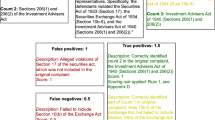Abstract
For any system that uses previous experience to solve problems in new situations, it is necessary to identify the features in the situation that should match features in the previous cases through some process ofsituation analysis. In this paper, we examine this problem in the legal domain, where lawyers know it asissue spotting. In particular, we present an implementation of issue spotting in CHASER, a legal reasoning system that works in the domain of tort law.
This approach is a compromise between generality and efficiency, and is applicable to a range of problems and domains besides legal reasoning. In particular, it presents a principled way to use multiple cases for a single problem by exploiting the inherent structure present in many domains.
Similar content being viewed by others
References
American Law Institute. 1981.Restatement of the Law, Second: Contracts, 2d. American Law Institute Publishers, St. Paul, MN.
Ashley, K. D. 1991.Modeling Legal Argument: Reasoning with Cases and Hypotheticals. Cambridge, MA: MIT Press.
Branting, L. K. 1991. Reasoning with Portions of Precedents. In Proceedings ofThe Third International Conference on Artificial Intelligence and Law. Oxford, ACM Press.
Charniak, E. & McDermott, D. 1985.Introduction to Artificial Intelligence. Reading, MA: Addison-Wesley.
Cuthill, B. B. 1991. A Retrieval Strategy for Cross-Context Legal Cases. In Proceedings ofThe 4th UNB Artificial Intelligence Symposium. Fredericton, NB, Canada.
Cuthill, B. B. 1992. Situation Analysis, Precedent Retrieval, and Cross-context Reminding in Case-Based Reasoning. PhD thesis, Department of Computer Science and Engineering, University of Connecticut. (Technical report No. CSE-TR-92-3).
Davis, E. 1990.Representations of Commonsense Knowledge. San Mateo, CA: Morgan-Kauffmann Publishers, Inc.
Delaney, J. 1987.Learning Legal Reasoning. Bogota, NJ: John Delaney Publications.
Gardner, A. von der Leith 1987.An Artificial Intelligence Approach to Legal Reasoning. Cambridge, MA: MIT Press.
Gibbons, H. 1990.The Death of Jeffrey Stapleton: Exploring the Way Lawyers Think. Concord, NH: Franklin Pierce Law Center. (manuscript).
Hafner, C. 1987. Conceptual Organization of Case Law Knowledge Bases. In Proceedings ofThe First International Conference on Artificial Intelligence and Law. Boston: ACM Press.
Hafner, C. 1990. An Integrated Model of Deep Structure and Surface Structure in Legal Reasoning. In Proceedings ofThe AAAI Workshop on AI and Legal Reasoning.
McCarty, L. Thorne. 1989 A Language for Legal Discourse: i. Basic Features. In Proceedings ofThe Second International Conference on Artificial Intelligence and Law. Vancouver: ACM Press.
McCarty, L. Thorne. 1990. A I and Law: How to Get There from Here. In Proceedings ofThe AAAI Workshop on AI and Legal Reasoning.
Prosser, W. L. 1971.Handbook of the Law on Torts. St. Paul, MN. West Publishing Co.
Prosser, W. L. Wade, J. W., & Schwartz, V. E., 1988.Cases and Materials on Torts. Westbury, NY: The Foundation Press, Inc.
Rissland, E. L. & Skalak, D. B. 1989. Combining Case-Based and Rule-Based Reasoning: A Heuristic Approach. In Proceedings ofThe Eleventh International Joint Conference on Artificial Intelligence, pp. 524–530, Detroit, MI.
Author information
Authors and Affiliations
Additional information
This work has been supported in part by the National Science Foundation, grant IRI-9110961.
Rights and permissions
About this article
Cite this article
Cuthill, B., McCartney, R. Issue spotting in CHASER. Artif Intell Law 2, 83–111 (1993). https://doi.org/10.1007/BF00871758
Issue Date:
DOI: https://doi.org/10.1007/BF00871758




